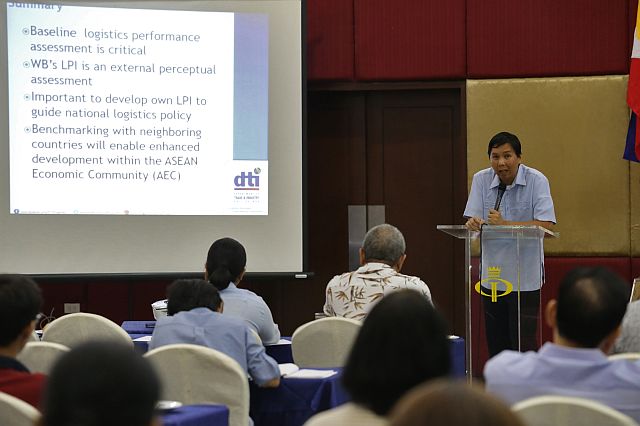
Jonathan Cabaltera, assistant chief of the Competitiveness Bureau’s supply chain and logistics management division, discusses indicators of logistics efficiency and logistics performance index to participants of a workshop in Cebu City. (CDN PHOTO/JUNJIE MENDOZA)
The Department of Trade and Industry (DTI) is pushing for the creation of the country’s own diagnostic tool that will be used to measure logistics efficiency.
While there are metrics used internationally, such as the World Bank’s Logistics Performance Index (LPI), these were not exactly “good” gauges of how a country performs.
“The index is perception-based. Scores are based on how foreign partners perceive logistics performance in a given country, so it doesn’t exactly paint an accurate picture of how things work on the ground. That’s why we’ll come up with our own diagnostic tool,” Jonathan Cabaltera, assistant chief of the Competitiveness Bureau’s supply chain and logistics management division, said during a survey workshop for the Logistics Efficiency Indicators (LEI) on Thursday.
Discussion
Around 70 private stakeholders, government representatives and members of the academe gathered in a half-day focus group discussion with the aim to develop a measurement and baseline assessment of Philippine logistical costs, time efficiency and reliability in transporting goods or cargoes and services, which are deemed critical for the sector’s policy formation.
The Competitiveness Bureau is an advisory body under the DTI tasked to come up with the LEI, which Cabaltera said they target to release by June of this year.
Cabaltera said they have already conducted the survey on Manila respondents, composed of business leaders from various sectors involved in logistics.
While the activity only gathered 20 respondents, and therefore could not produce conclusive results, provisional data showed a discrepancy between the LEI and the LPI.
LPI
According to the World Bank’s website, the LPI is an “interactive benchmarking tool created to help countries identify the challenges and opportunities they face in their performance on trade logistics and what they can do to improve their performance.”
In the 2016 LPI, the Philippines ranked 71st with a score of 2.86 out of 5 based on six dimensions: customs, infrastructure, international shipments, logistics competence, tracking and tracing, and timeliness.
Results from the survey in Manila, however, yielded a score of 3.31 out of 5.
Among the respondents, 41 percent said reliability was a problem, followed by cost at 31 percent, and time at 28 percent.
Perception
Most of the respondents or 67 percent said their logistical needs and requirements are outsourced, while 33 percent used in-house resources.
“Our perception is different here because we know the problem. Others, especially foreigners, only base their answers on what they read on the newspapers,” said Cabaltera.
Cabaltera said scores in certain dimensions could be higher or lower in the LEI than they are in the LPI.
Since the LPI is an external perceptual assessment, he said it was important for the national government to develop its own measurements to guide national legislation.
LPI’s impact
Nonetheless, Cabaltera said the LPI has an impact such that it raises awareness and pushes for needed reforms including improvements in connectivity, among others.
The model used to formulate the LEI in the Philippines is the same one that has been used in Indonesia and other Association of Southeast Asian Nations–member states.
The DTI targets to reach out to 300 respondents from all over the Philippines, including those in the cities of Iloilo, Davao and Cagayan de Oro City.
Red tape
More than cost, time or reliability, exporters and importers think red tape is the country’s biggest problem in terms of logistics.
“The cost is not that expensive, the congestion is not that bad here. Our biggest problem in this country is the red tape which actually prevents business from being made,” said Alexander Hey, Cebu Furniture Industry Foundation (CFIF) vice president for internal affairs.
Speaking on behalf of the whole furniture industry, he said that raw materials in the Philippines are quite expensive due to the “absolutely ridiculous” red tape measures being undertaken all over the country.